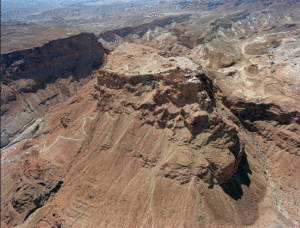The religious leader of the Jews at the time of the destruction of Jerusalem in AD 70 by the Romans was a rather well-known Rabbi Yochanan ben Zakkai who was a disciple of Hillel. The following information is found in the history written by Josephus the Jewish historian or either the Babylonian or the Jerusalem Talmuds since the Bible text ended with the writing of the book of Revelation in AD 68 or perhaps even earlier. Another major source document I used is found at jewishhistory.org/the-destruction-of-the-second-temple/ in order to write some excerpts for this Learning Activity.
As the narrative goes, there was an apparent agreement between the Jews trapped in the city and the attacking Roman Army to permit the dead to be taken out of the city each night to be buried. Yochanan ben Zakkai supposedly hid himself in a coffin to cross the enemy lines outside the city as he had made the decision to attempt to negotiate an agreement with Vespasian. Zakkai was able to reach Vespasian in this manner and started his negotiation by informing Vespasian that Vespasian was about to become the emperor of Rome. While the conversation was going on a messenger arrived and told Vespasian that he was indeed appointed the emperor! In any event, Vespasian gave Zakkai an audience and Zakkai made a series of requests from Vespasian. One of the requests was to spare the town of Yavne and to let a group of Jews (Sanhedrin) flee Jerusalem to that city. Yavneh, also known as Jabneh in the Bible, during Greco-Roman times was also known as Jamnia and located about 15 miles south of Tel Aviv and 4 miles from the Mediterranean Sea.
Vespasian granted Zakkai’s request and the Jewish contingent is said to have established a Jewish academy in Yavne which provided a degree of continuance to the Jewish religion for those who had escaped the carnage that took place in Jerusalem! It is reported that the academy that was set up in the city of Yavne was quite influential even to the point where in AD 100 a group of Rabbis set the final cannon of the Hebrew scripture as they met in that city.
With the destruction of the Temple the Romans continued to exterminate as many of the Jews as they could locate. The final place controlled by the Jews was the fortress of Masada, which was commanded by Elazar ben Yair. ben Yair had escaped Jerusalem and, together with about a thousand people, found refuge in Masada. The Romans went to Masada and established a three year siege against the heavily fortified and geographically almost impossible place to enter. The Romans used 30,000 Jewish slaves to build an enormous ramp up a sheer cliff to conquer Masada. Masada held out until AD 73 when the ramp was almost completed and it became obvious that the Romans were going to win at their efforts to enter the compound. Josephus records a story where Elazar ben Yair called a meeting and declared that they were not going to allow themselves to become slaves to Rome. Instead they would commit suicide which is what they did. When the Romans entered the fortress they found only the corpses of the Jews.
Aerial View of Masada
 Ramp Built by Rome Using 30,000 Jewish Slaves!
Ramp Built by Rome Using 30,000 Jewish Slaves!
After the destruction of Jerusalem the Romans rebuilt the city and declared it a pagan city from which all Jews were excluded. The city was named Aelia Capitolina by the Roman Emperor Hadrian in AD 130 at which time a violent response to the Romanization of the city broke out in the Bar Kokhba Revolt which lasted from AD 132 to 136. I recommend reading from the website drivethruhistoryadventures.com/roman-destruction-rebuilding-jerusalem for a more complete historical account of the history of this time period which I will briefly summarize in the following paragraphs.
After its destruction in AD 70 much of the city lay dormant and unoccupied except for Roman camps of the 10th Legion.Soldiers remained stationed there for the next 62 years until the Bar Kokhba Revolt broke out. This revolt seems to have been triggered by the plans of Emperor Hadrian to include Roman temples in the rebuilding of Jerusalem, and particularly on the site of the Temple of Yahweh, which was revealed when he visited the city around AD 130. The plan called for the building of a temple to Jupiter which apparently was an attempt to show the supremacy of Rome, its gods, and its Emperor.
Soon after Hadrian left the area, a full scale revolt began, and the temple of Jupiter on the Temple Mount was not completed. After over three years of fighting with many casualties the Romans subdued the rebels and their false messiah Simon Bar Kokhba, who was executed along with other leaders of the rebellion. Hadrian completely banned Judaism in the city and barred Judeans from entering Jerusalem except once a year on the 9th month of Av, the day commemorating the destruction of the Temple in AD 70.
When Constantine became Emperor in AD 313, he declared Jerusalem a Christian city.
In AD 637 Jerusalem was conquered by Muslims and in AD 691 they erected a mosque on the site where the Jewish Temple previously stood.
In 1542 the Muslim ruler rebuilt the city walls, and they still stand today.
Jerusalem remained under Muslim control until 1967, when it was retaken by the Jews. The mosque on the temple hill still stand today and it is hard to believe that it will ever revert back to Jewish control at any time in the future.
